Abstract
Purslane is often labeled as a noxious weed in Florida, thriving ubiquitously in the state's favorable climate. However, this seemingly pesky plant is also known as a nutritional powerhouse, particularly in markets in Asia and other continents. Regarded as the king of vitamin A among vegetables, 100 grams (3.5 ounces) of raw purslane leaves and stems boast an impressive 1320 IU, equivalent to 396 µg of vitamin A. This level surpasses that found in broccoli, tomato, and lettuce (Table 1). In addition to its vitamin A prowess, purslane claims the throne in the realm of vitamin E with 12.2 milligram per 3.5 ounces of raw purslane leaves and stems (Table 1). A mere 3.5 ounces of purslane can fulfill a substantial 81% of an individual’s daily vitamin requirements. Purslane can be used as a vegetable source of omega-3 fatty acids, which are found mostly in fish and flax seeds (Uddin et al. 2014). Scaling up to 8 ounces provides an ample supply to meet the daily needs of both vitamins A and E. The nutritional wealth of purslane shows its popularity among consumers who regularly acquire it from local ethnic groceries. The pivotal factor hinges on the timing of harvest, the point at which purslane plants attain a height of 5 to 6 inches. Beyond this stage, purslane becomes excessively fibrous and aged, making it unsuitable for consumption and necessitating removal through weeding. This publication article provides a comprehensive overview of purslane, delving into its botany, garden production, harvest practices, and both culinary and nutritional value. It aims to assist growers, Extension agents, and consumers in understanding when to savor its nutritional benefits and when to weed it from farmlands.
Introduction
Purslane (Portulaca oleracea L.), commonly known by various names such as common purslane, little hogweed, portulaca, red root, or verdolaga, belongs to the family Portulacaceae. In south Florida, it manifests as an annual but displays characteristics of a tropical perennial succulent, particularly in USDA growing zones 10–11 (Chugh et al. 2019).
Historically, the purslane family encompassed 21 genera and 580 species. However, contemporary classifications, such as the Angiosperm Phylogeny Group (APG) III system by Christenhusz and Byng in 2009, have narrowed the definition to include only one genus, Portulaca. Other genera that were previously part of the Purslane family have been reclassified and now belong to different families: the miner's lettuce family, Montiaceae; the Didierea family, Didiereaceae; the Anacampserote family, Anacampserotaceae; and the Slipperwort family, Talinaceae (Angiosperm Phylogeny Group 2009).
The APG developed a modern and mostly molecular-based system of plant taxonomy. This system has advanced four versions today: the first version was published in 1998, and then it was replaced by the improved APG II, III, and IV in 2003, 2009, and 2016, respectively.
Globally, there are approximately 40 purslane cultivars (Alam et al. 2014), each containing various medicinally active ingredients and micronutrients. Purslane is versatile, commonly used as food, medicine, and forage (Rao et al. 2014). Notably, it is recognized as one of the most used medicinal plants termed as “Global Panacea” by the World Health Organization (Shanker and Debnath 2015; Dehghan et al. 2016).
As mentioned, purslane is also called portulaca even though there are more than 100 other portulaca species. For example, moss-rose purslane (Portulaca grandiflora) is a well-known ornamental plant rather than a vegetable (Huxley 1992). The name Portulaca is derived from the Latin word "laca," meaning milk. Portulaca refers to the milk-juice content of the plant (Boulos. 1984). The plant can reach heights of 12 to 16 inches, with smooth, purple-red stems that are mostly prostrate (Figure 1). Its leaves, 0.4 to 1.2 inches in length and 0.2 to 0.6 inches in width, are alternate or opposite, flat, hypertrophic, and obovate (Figure 2), while clustered at stem joints and ends (Uddin et al. 2014). The flowers lack pedicels, are yellow, and cluster in groups of three to five, each with a diameter of 0.2 inches on the stem end (Figure 2). Purslane produces tiny seeds that are black when mature and occasionally red or brown when immature. The seeds are 0.02 to 0.04 inches in length, typically with granulate to flat-stellate surfaces (Figure 3). The thousand-seed weight of purslane is approximately 7 to 9 g, with seed vigor remaining for three to four years.
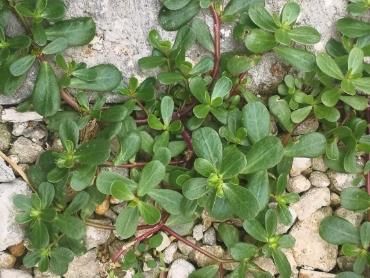
Credit: Guodong Liu, UF/IFAS
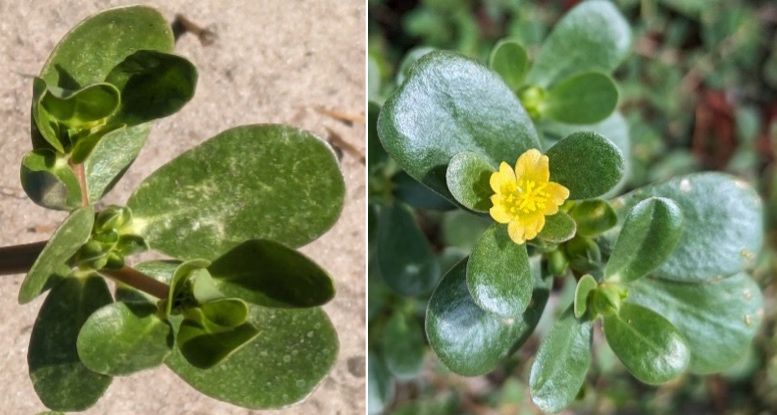
Credit: Guodong Liu, UF/IFAS
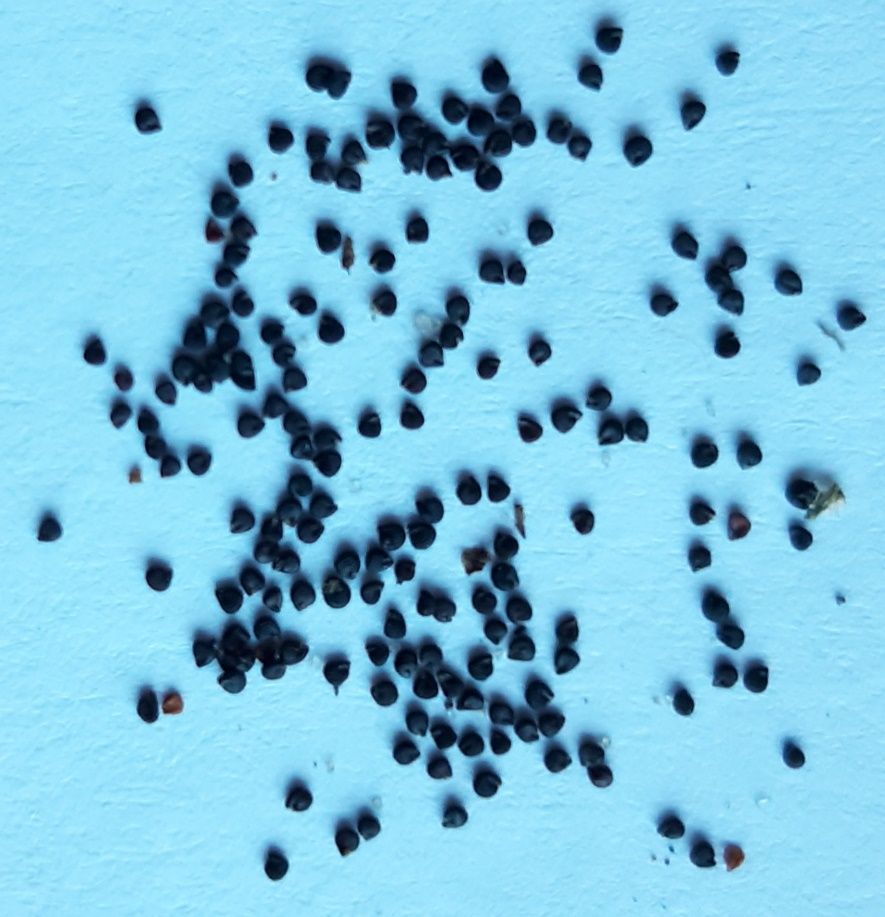
Credit: Xueyan Zhang, former visiting scientist, UF/IFAS
Why should we weed purslane?
Purslane is categorized as a weedy annual across much of North America (Kopsell et al. 2016). A weed, in essence, refers to a plant growing in an undesirable location. In the case of purslane, it is commonly found in vegetable fields, competing with vegetable crops for essential resources such as nutrients, water, and sunlight (Ghamari et al. 2016). As a result, purslane is regarded as one of the most noxious weeds due to its ability to establish a persistent presence wherever introduced. The plant exhibits extensive spreading, forming a mat-like growth in fields (Figure 4). Consequently, purslane plants growing in areas not designated for purslane production are considered weeds and are mandated for removal (Proctor 2013).
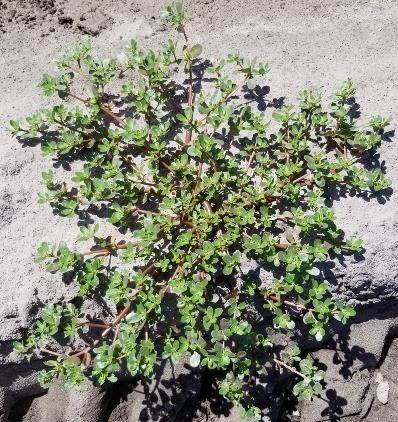
Credit: Guodong Liu, UF/IFAS
The conducive climate of Florida further facilitates the growth of purslane. The plant thrives voluntarily in diverse environments, ranging from crop fields to arid soils, sidewalks, and rocky driveways (Figure 5). In Florida, purslane is typically considered a weed.
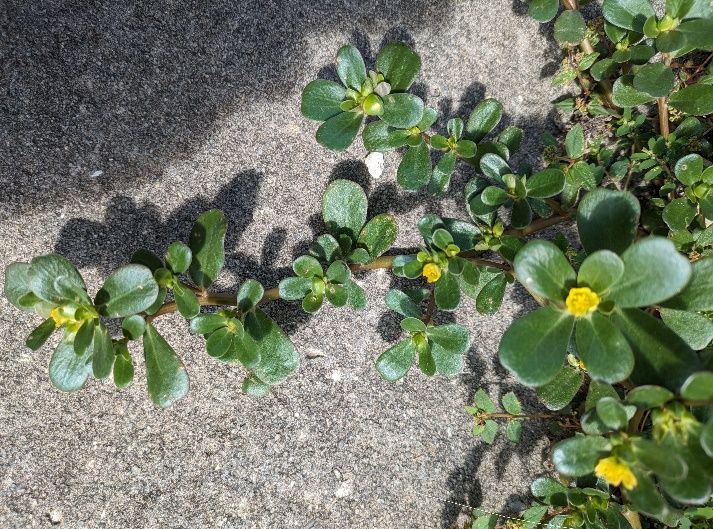
Credit: Guodong Liu, UF/IFAS
As previously mentioned, there are over 100 species of portulaca, but not all of them have edible leaves and stems, tasting mildly tangy or lemony. It's crucial to correctly identify purslane species before consumption, as some may differ slightly in flavor or texture. Common purslane (Portulaca oleracea) is the most well-recognized, edible variety. It typically grows close to the ground, spreading and rooting at nodes. Here are some general guidelines to help identify edible purslanes:
- Look for thick, succulent leaves and stems.
- Check for small yellow flowers clustered in leaf axils.
- Avoid purslane with hairy or fuzzy leaves, as this may indicate a different, potentially toxic plant.
In addition to common purslane, there are other edible varieties:
- Golden purslane (Portulaca sativa): Similar to common purslane but with golden-yellow leaves.
- Red-stemmed purslane (Portulaca oleracea var. sativa): Features red stems instead of green.
- Garden purslane (Portulaca umbraticola): Less common but still edible, with smaller, thinner leaves compared to common purslane. It also bears small, yellow, clustered flowers and may have a slightly different taste.
Always ensure that purslane plants are sourced from pesticide-free areas if harvesting them for consumption. When unsure, consult a reliable field guide or seek assistance from your county Extension agents or someone knowledgeable about edible wild plants. Remember to positively identify plants before consuming them, and exercise caution when foraging to avoid accidentally ingesting toxic plants.
Eating purslane serves as a form of weeding, as it prevents the plant from spreading through seed dispersal. Within four to six weeks after emergence, small yellow flowers appear in leaf clusters, maturing into abundant tiny, black, kidney-shaped seeds by late summer. A single purslane plant can produce over 200,000 seeds annually, contributing to future outbreaks. Purslane grows close to the ground, with creeping arms that root as they extend, forming mats up to 3 feet wide (Figure 4). Therefore, consuming purslane within four weeks of emergence effectively controls its spread by eliminating the flowering stage and aiding in weed management.
Why should we eat purslane?
Purslane is not only appreciated as a specialty vegetable crop but is also recognized globally for its nutritional richness (Kopsell et al. 2016). Its cultivation is widespread, and it holds a special place in culinary practices in various parts of the world.
Purslane is abundant in essential nutrients, particularly mineral elements like calcium, magnesium, potassium, zinc, copper, iron, manganese, selenium, and more. The chemical composition of this crop encompasses fatty acids, organic acid compounds, ketone-like compounds, alkaloid compounds, terpenoids, amino acids, and inorganic salts. Additionally, it is a rich source of polysaccharides, proteins, ketones, total flavonoids, ω-3-unsaturated fatty acids, and α-linolenic acid, which is essential for human health (Simopoulos et al. 2013), as well as health-promoting compounds such as norepinephrine and melatonin (Cui et al. 2007; Umezawa et al. 2002; Suzuki et al. 2000; Simopoulos et al. 2013). Purslane contains extremely high vitamins A and E. The vitamin A content in purslane produce is approximately 9.4 times greater than that in tomatoes, 12.8 times greater than in broccoli, and 2.4 times greater than in lettuce (Tables 1 and 2). Purslane is an excellent source of omega-3 fatty acids such as alpha-linolenic acid (ALA, 18: 3 w3, C18H30O2). It contains the greatest amount of alpha-tocopherol at 22.2 milligrams per 100 grams of fresh weight, while a common green leafy vegetable possesses only 4 milligrams per 100 grams of fresh weight.
According to Organic Facts, there are numerous potential health benefits associated with consuming purslane (Staughton 2021). A comprehensive review of purslane's medicinal uses in 30 countries was conducted by Iranshahy et al. in 2017. The findings of the review unveiled an extensive list of diseases treated with purslane. As a result, purslane is not only acknowledged as a culinary delight but is also embraced for its medicinal properties, contributing to its status as a valued vegetable in many regions across the globe (Chugh et al. 2019; Kopsell et al. 2016; Proctor 2013).
How do we grow purslane?
In Florida, there is no commercial production of purslane, but residents can grow this vegetable crop in gardens or containers filled with topsoil or all-purpose potting soil mix (Figure 6). Purslane thrives in moist, well-drained soil, requiring a sunny environment. Optimal growth of purslane relies on bioavailable nitrogen, necessitating consistently moist soil during the growth period. Quality leaf production is hindered in dry conditions. For desirable yields in Florida, grow purslane on sandy soil with timely irrigation, appropriate nutrient supply, and ample sunlight.
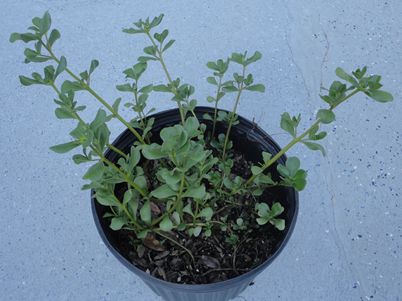
Credit: Guodong Liu, UF/IFAS
Given the small size of purslane seeds, row seeding is recommended. Plant seeds in shallow grooves, 8 to 10 inches wide. When seedlings reach around 6 inches, initiate thinning until plant spacing is 3 to 4 inches. If buds appear in the summer, picking them and applying nitrogen delays flowering. Nitrogen application is a common practice after each harvest of this vegetable crop. Although UF/IFAS does not provide specific fertilization recommendations for this crop, growers often rely on general guidance. For instance, following each harvest, nitrogen fertilizer such as ammonium sulfate or urea is applied through fertigation at a N concentration of 600 ppm (Nastou et al. 2021).
Purslane faces minimal insect pests; however, diseases like powdery mildew and leaf spot may occur. Chemical control is generally unnecessary.
How do we harvest purslane?
Purslane plants typically yield a crop six to eight weeks after seeding, best managed by a cut-and-come-again approach. The prime time for optimal harvest is in the early morning. Seedlings are best harvested at a height of approximately 5 to 6 inches (Figure 7). The recommended harvesting standard is to cut when the tender stem measures 4 to 6 inches in length, ideally before flowering, with a harvest interval of every 10 to 20 days until November. In this early growth stage, the stalk fiber content is minimal, offering a delightful culinary quality and boasting high medicinal value. Two or three days following each harvest, it's common practice to apply nitrogen fertilizer at a rate of 30 ounces per 1000 square feet (Mu 2016).
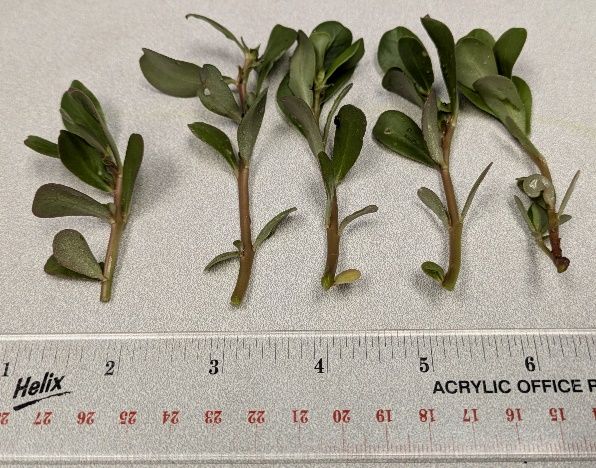
Credit: Guodong Liu, UF/IFAS
This crop has a great strategy to deal with hot weather and water stress conditions. In these arid conditions, purslane switches to a photosynthesis pathway by using Crassulacean Acid Metabolism (CAM) as a means of conserving moisture from photosynthesis, employing the C3 pathway, also known as the Calvin Cycle. In the CAM pathway, the leaves open their stomata and trap carbon dioxide (CO2) at night when temperatures are lower than daytime and moisture loss is reduced. The carbon dioxide is then stored as malic acid in the vacuoles of the plant's cells. During the day, when the stomata are closed to conserve water, the stored malic acid is released and broken down to release carbon dioxide for use in photosynthesis. This unique carbon fixation pathway allows purslane plants to efficiently use water and thrive in dry and hot environments.
How do we collect purslane seeds?
Allow the plants to naturally branch, flower, and produce seeds. A single purslane pod can produce 50 to 60 seeds. Harvest the seeds approximately 25 to 30 days after flowering when they turn brown or black. It is crucial to harvest at this stage to prevent the seeds from scattering and being lost on the ground. A wide mouth container is a convenient tool to collect the seeds. Just take the lid of the container and gently put the lid under the pod. Use your fingers to press the pod and the seeds will spit out to the lid. Let the seeds air-dry and keep them in the container for the next growing season.
What are the uses of purslane?
Purslane, celebrated for its versatility and nutritional richness, extends its utility to the culinary realm and beyond. In addition to being a beneficial leafy vegetable for people (Figure 8), purslane proves valuable as livestock feed, particularly for poultry and rabbits. Its aesthetic qualities also make it a sought-after ornamental plant in landscaping, where selected varieties enhance visual appeal. Notably, purslane acts as a bioaccumulator by absorbing and accumulating minerals, such as calcium (Ca), magnesium (Mg), potassium (K), iron (Fe), Zinc (Zn), and so forth, from the soil and facilitating their removal when harvested, thus contributing to soil improvement. Its ability to form a dense ground cover further positions purslane as an effective tool in suppressing weeds and maintaining soil moisture in gardens.
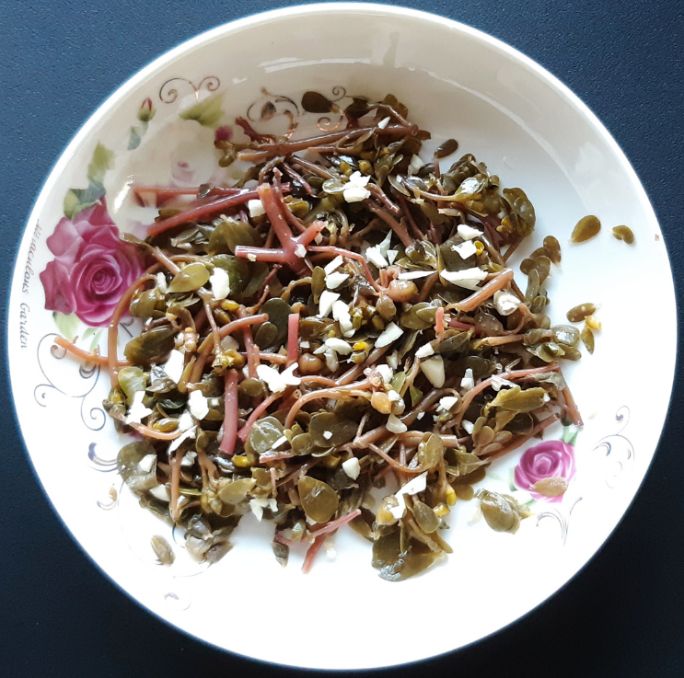
Credit: Xueyan Zhang, UF/IFAS
Culinary Uses
Purslane is frequently incorporated into salads, soups, stews, and culinary sauces. When subjected to cooking, purslane undergoes a transformation, developing a mucilaginous texture that serves as a natural thickener, particularly enhancing the consistency of soups and stews.
In Greece, a popular culinary practice involves frying purslane leaves in olive oil and combining them with feta cheese, tomato, onion, garlic, and oregano, resulting in a flavorful dish (Vit et al. 2023; Wright 2012). Another delightful preparation involves cooking purslane with garlic and/or pork, creating a delicious and nutritious addition to the culinary repertoire. The mucilaginous quality of cooked purslane contributes to its texture and enhances the overall culinary experience, making it a prized ingredient in various delectable dishes.
Soil Biodesalination
Soil salinity presents a significant obstacle to vegetable farming, often resulting in reduced yields and rendering salt-sensitive crops unsuitable for cultivation. In Florida, with approximately 8,436 miles of coastline, many commercial vegetable farms are located near the ocean, exposing crops to salinity stress. Irrigation wells in this region typically range from 400 to 100 feet deep. In 2013, in the Hastings area, irrigation water salinity levels from some deep wells exceeded 12 decisiemens per meter, leading to economic losses of around $900 per acre in potato production.
However, purslane demonstrates exceptional salt tolerance, making it a viable option for vegetable cultivation in regions with high chloride-based salinity in irrigation water (Teixeira and Carvalho 2008). Purslane has the remarkable ability to extract salt from the soil under saline conditions. Whether grown as an intercrop or during a single growing season, it can effectively remove significant amounts of chloride and sodium from the soil. For instance, at a soil salinity level of 6.5 decisiemens per meter, purslane can extract approximately 187 pounds per acre (210 kilograms per hectare) of chloride and 58 pounds per acre (65 kilograms per hectare) of sodium (Kiliç, Kukul, and Anaç 2008). This salt-extraction capability allows for the successful growth of salt-sensitive crops on saline soils, thereby mitigating the adverse effects of salinity.
Furthermore, in saline growth conditions, purslane can positively influence companion plants such as tomatoes. Its presence in the growing environment can enhance the resilience and productivity of these companion crops, leading to improved vegetable outcomes in areas affected by salinity (Graifenberg et al. 2003).
Take-Home Message
Purslane, traditionally labeled a noxious weed in Florida, contradicts its weedy classification with its global acclaim for rich nutrient content and extensive health benefits. Recognized worldwide, purslane serves both culinary and medicinal purposes, boasting vitamin levels. For example, its vitamin A level surpasses those found in common vegetables like tomatoes and broccoli by 10 to 13 times. This exceptional nutritional profile holds significant promise for promoting human health.
Florida's amenable climate provides an opportune setting for cultivating purslane as a vegetable crop, necessitating meticulous attention to soil conditions, moisture levels, and sunlight exposure. Harvesting is a critical element, ensuring optimal quality during the early growth stage and facilitating seed collection in the late stage through natural processes.
Beyond its culinary applications, purslane's nutritional richness has positioned it as a prized addition to various dishes. Its medicinal properties, including potent antibacterial and anti-inflammatory effects, make it an appealing choice for health-conscious diets and innovative food products. Despite the absence of commercial purslane production in Florida, cultivating this crop in gardens offers a chance to diversify the state's food system and contribute to the well-being of Floridians.
While purslane is frequently designated a noxious weed in crop fields, acknowledging its remarkable nutrient and medicinal benefits prompts a paradigm shift. Viewing purslane as a valuable vegetable rather than a mere weed opens new avenues for its inclusion in diets and encourages cultivation for both culinary and medicinal purposes. Embracing purslane in this manner redefines its status and underscores its potential to contribute to a healthier and more diverse food landscape.
Table 1. Vitamin Content per 3.5 ounces Raw Vegetable.
Table 2. Nutritional Value of Portulaca olerace.
References
Alam, M. A., A.S. Juraimi, M. Y. Rafii, A.A. Hamid, F. Aslani. 2014. “Screening of Purslane (Portulaca oleracea L.) Accessions for High Salt Tolerance.” The Scientific World Journal: 1–12. https://doi.org/10.1155/2014/627916
Angiosperm Phylogeny Group (APG). 2009. “An Update of the Angiosperm Phylogeny Group Classification for the Orders and Families of Flowering Plants: APG III.” Botanical Journal of the Linnean Society 161 (2): 105–121. https://doi.org/10.1111/j.1095-8339.2009.00996.x
Boulos, L. 1984. “The Genus Portulaca in Egypt.” Willdenowia 14 (1): 41–46.
Chugh, V., V. Mishra, S. V. Dwivedi, and K. D. Sharma. 2019. “Purslane (Portulaca oleracea L.): An Underutilized Wonder Plant with Potential Pharmacological Value.” The Pharma Innovation Journal 8 (6): 236–246. https://www.thepharmajournal.com/archives/2019/vol8issue6/PartE/8-5-92-356.pdf
Cui, L., G. Du, D. Zhang, H. Liu, and J. Chen. 2007. “Purification and Characterization of Transglutaminase from a Newly Isolated Streptomyces hygroscopicus.” Food Chemistry 105 (2): 612–618. https://doi.org/10.1016/j.foodchem.2007.04.020
Dehghan, F., R. Soori, K. Gholami, M. Abolmaesoomi, A. Yusof, S. Muniandy, S. Heidarzadeh, P. Farzanegi, and M. A. Aazarbayjani. 2016. “Purslane (Portulaca oleracea) seed consumption and aerobic training improves biomarkers associated with atherosclerosis in women with type 2 diabetes (T2D).” Scientific Reports 6: 37819. https://doi.org/10.1038/srep37819
Ghamari, H., J. S. Kolvanagh, S. H. Sabaghpour, and A. D. M. Nassab. 2016. “Effects of Chemical and Biological Fertilizers on Some Morpho-Physiological Traits of Purslane (Portulaca oleracea L.) and Dragon’s Head (Lallemantia iberica Fisch. & CA Mey) Cultivated under Intercropping System.” Notulae Scientia Biologicae 8 (1): 112–117. https://doi.org/10.15835/nsb819755
Graifenberg, A., L. Botrini, L. Giustiniani, F. Filippi, and M. Curadi. 2003. "Tomato Growing in Saline Conditions with Biodesalinating Plants: Salsola soda L. and Portulaca oleracea L." Acta Horticulturae 609: 301–305. https://doi.org/10.17660/ActaHortic.2003.609.45
Kiliç, C. C., Y. S. Kukul, and D. Anaç. 2008. "Performance of Purslane (Portulaca oleracea L.) as a Salt-removing Crop." Agricultural Water Management 95 (7): 854–858. https://doi.org/10.1016/j.agwat.2008.01.019
Huxley, A. 1992. The New Royal Horticultural Society Dictionary of Gardening. New York: Groves Dictionaries Inc. ISBN 10: 1561590010 / ISBN 13: 9781561590018.
Iranshahy, M., B. Javadib, M. Iranshahi, S. P. Jahanbakhsh, S. Mahyari, F. V. Hassani, and G. Karimi. 2017. “A Review of Traditional Uses, Phytochemistry and Pharmacology of Portulaca oleracea L.” Journal of Ethnopharmacology 205: 158–172. https://doi.org/10.1016/j.jep.2017.05.004
Kopsell, D. A., K. J. Whitlock, C. E. Sams, and D. E. Kopsell. 2016. “Nutritionally important pigments in purslane (Portulaca oleracea) differ between cultivars and in response to nitrogen.” HortScience 51 (6): 784–787. https://doi.org/10.21273/hortsci.51.6.784
Nastou, E., G. Thalassinos, N. Polyzos, V. Antoniadis, and S. A. Petropoulos. 2021. “The Effect of Nitrogen Fertilization Rate on Growth and Physiological Parameters of Three Purslane Genotypes Grown in a Soilless Cultivation System.” Acta Horticulturae 1321: 125–132. https://doi.org/10.17660/ActaHortic.2021.1321.16
Proctor, C. A. 2013. “Biology and Control of Common Purslane (Portulaca oleracea L.).” Ph.D. diss. University of Nebraska-Lincoln. https://www.proquest.com/docview/1458622573?pq-origsite=gscholar&fromopenview=true&sourcetype=Dissertations%20&%20Theses
Rao, N. K., M. Shahid, A. Al Shankiti, and I. Elouafi. 2014. “Neglected and Underutilized Species for Food and Income Security in Marginal Environments.” Acta Horticulturae 1051. https://doi.org/10.17660/ActaHortic.2014.1051.8
Shanker, N., and S. Debnath. 2015. “Impact of Dehydration of Purslane on Retention of Bioactive Molecules and Antioxidant Activity.” Journal of Food Science and Technology 52: 6631–6638. https://doi.org/10.1007/s13197-015-1741-3
Simopoulos, A. P, H. A. Norman, J. E. Gillaspy, and J. A. Duke. 2013. "Common Purslane: A Source of Omega-3 Fatty Acids and Antioxidants." Journal of the American College of Nutrition 11 (4): 374–382. https://doi.org/10.1080/07315724.1992.10718240
Staughton, J. 2021. “Purslane: Nutrition & Health Benefits.” Organic Facts, July 23, 2021. https://www.organicfacts.net/health-benefits/vegetable/purslane.html
Suzuki, S., Y. Izawa, K. Kobayashi, Y. Eto, S. Yamanaka, K. Kubota, and K. Yokozeki. 2000. “Purification and Characterization of Novel Transglutaminase from Bacillus subtilis Spores.” Bioscience, Biotechnology, and Biochemistry 64 (11): 2344–2351. https://doi.org/10.1271/bbb.64.2344
Teixeira, M., and I. S. Carvalho. 2008. "Effects of Salt Stress on Purslane (Portulaca oleracea) Nutrition." Annals of Applied Biology 154 (1): 77–86. https://doi.org/10.1111/j.1744-7348.2008.00272.x
Uddin, M. K., A. S. Juraimi, M. S. Hossain, M. A. Nahar, M. E. Ali, and M. M. Rahman. 2014. “Purslane Weed (Portulaca oleracea): A Prospective Plant Source of Nutrition, Omega-3 Fatty Acid, and Antioxidant Attributes.” Scientific World Journal 2014: 1–6. https://doi.org/10.1155/2014/951019
Umezawa, Y., T. Ohtsuka, K. Yokoyama, and N. Nio. 2002. “Comparison of Enzymatic Properties of Microbial Transglutaminase from Streptomyces sp.” Food Science and Technology Research 8 (2): 113–118. https://doi.org/10.3136/fstr.8.113
Vit, P., B. Santiago, J. Ruiz, R. A. Vielma, J. Guevara, and Z. Wang. 2023. “Bibliometric Review, Proximal Composition, and Gastronomic Proposals of The Tasty Weed Portulaca Oleracea L., the Richest Plant in Omega 3 Fatty Acid Known as Purslane or Verdolaga.” Interciencia 48 (1): 8–19. https://www.interciencia.net/wp-content/uploads/2023/02/01_6946_A_Vit_v48n1_12.pdf
Wright, C. A. 2012. Mediterranean Vegetables: A Cook's ABC of Vegetables and their Preparation in Spain, France, Italy, Greece, Turkey, The Middle East, and North Africa with More Than 200 Authentic Recipes for The Home Cook. Boston, Massachusetts: Harvard Common Press.
Further Reading
Alu’datt, M. H., T. Rababah, M. N. Alhamad, A. Al-Tawaha, A. R. Al-Tawaha, S. Gammoh, K. I. Ereifej, G. Al-Karaki, H. R. Hamasha, C. C. Tranchant, and S. Kubow. 2019. “Herbal Yield, Nutritive Composition, Phenolic Contents and Antioxidant Activity of Purslane (Portulaca oleracea L.) Grown in Different Soilless Media in a Closed System.” Industrial Crops and Products 141: 111746. https://doi.org/10.1016/j.indcrop.2019.111746
Chen, C. -J., W. -Y. Wang, X. -L. Wang, L. -W. Dong, Y. -T. Yue, H. -L. Xin, C. -Q. Ling, and M. Li. 2009. “Anti-hypoxic Activity of the Ethanol Extract from Portulaca oleracea in Mice.” Journal of Ethnopharmacology 124 (2): 246–250. https://doi.org/10.1016/j.jep.2009.04.028.
Kim, Y. -O., S. -W. Lee, S. W. Na, H. R. Park, and E. S. Son. 2015. “Anti-inflammatory Effects of Portulaca oleracea L. on the LPS-induced RAW 264.7 Cells.” Journal of Medicinal Plant Research 9 (12): 407–411. https://doi.org/10.5897/JMPR2012.1183
Haston, E., J. E. Richardson, P. F. Stevens, M. W. Chase, and D. J. Harris. 2009. “The Linear Angiosperm Phylogeny Group (LAPG) III: A Linear Sequence of the Families in APG III.” Botanical Journal of the Linnean Society 161 (2): 128–131. https://doi.org/10.1111/j.1095-8339.2009.01000.x
Lee, A. S., Y. J. Lee, S. M. Lee, J. J. Yoon, J. S. Kim, D. G. Kang, and H. S. Lee. 2012. “Portulaca oleracea ameliorates diabetic vascular inflammation and endothelial dysfunction in db/db mice.” Evidence-Based Complementary and Alternative Medicine 2012: 741824. https://doi.org/10.1155/2012/741824
McGee, H. 2004. On Food and Cooking. New York: Scribner. ISBN 978-0684800011
Zhao, H., S. Li, F. Luo, Q. Tan, H. Li, and W. Zhou. 2015. “Portulaca oleracea L. aids calcipotriol in reversing keratinocyte differentiation and skin barrier dysfunction in psoriasis through inhibition of the nuclear factor κB signaling pathway.” Experimental and Therapeutic Medicine 9 (2): 303–310. https://doi.org/10.3892/etm.2014.2116
Zhou, Y. -X., H. -L. Xin, S. -J. Rahman, C. Peng, and H. Zhang. 2015. “Portulaca oleracea L: A Review of Phytochemistry and Pharmacological Effects.” Biomed Research International: 925631. https://doi.org/10.1155/2015/925631